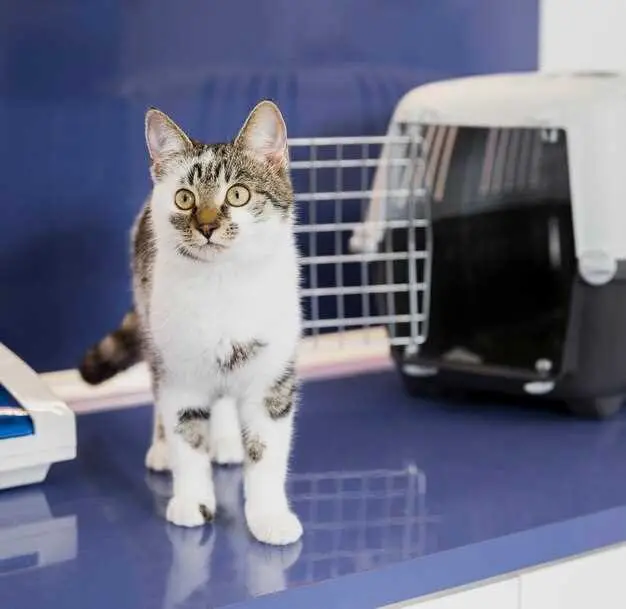
Have you ever wondered how cats are able to find their litter box even when it’s hidden away in the farthest corner of your house? The answer lies in their exceptional sense of smell. Cats have an incredible ability to detect odors and can pick up scents that are imperceptible to humans.
The average cat’s sense of smell is estimated to be between 9 and 16 times stronger than that of humans. This means that they can detect odors that are much more faint and from much farther away than we can. For example, while humans might be able to smell something from a distance of about 20 feet, a cat can detect that same smell from over 100 feet away!
When it comes to their litter box, cats rely on their keen sense of smell to locate it easily. Even if you’ve moved the litter box to a different part of the house or hidden it behind closed doors, your cat will still be able to find it. They can pick up on the unique scent of their urine and feces, which helps them navigate their way back to their designated bathroom area.
But just how far away can a cat smell its litter box? While it varies from cat to cat, some sources suggest that cats can detect the scent of their litter box from distances of up to a mile away! This is truly remarkable and shows just how important their sense of smell is to their daily lives.
Understanding a Cat’s Sense of Smell
A cat’s sense of smell is incredibly powerful and plays a crucial role in its daily life. Understanding how a cat’s nose works can help provide insight into their behavior and preferences.
Cats have a highly developed sense of smell, far superior to that of humans. While humans have approximately 5 million smell receptors in their noses, a cat has about 200 million. This enables them to detect odors that are undetectable to us.
The anatomical structure of a cat’s nose also contributes to their exceptional sense of smell. They have a special organ called the Jacobson’s organ, located on the roof of their mouth behind the upper front teeth. This organ allows cats to process and analyze scents in a way that intensifies their olfactory experience.
Additionally, a cat’s sense of smell is closely linked to their survival instincts. They use their sense of smell to hunt for prey, identify potential threats, and navigate their environment. Cats can also use their keen sense of smell to recognize familiar scents, such as their litter box or their human’s scent.
A cat’s sense of smell is not only powerful but also highly sensitive. They can detect odors at concentrations much lower than what humans can perceive. This sensitivity explains why cats may react strongly to certain smells, such as the smell of certain foods or pheromones.
Understanding a cat’s sense of smell is crucial in providing them with a comfortable and enriching environment. By considering their olfactory needs, such as providing them with a clean litter box and avoiding strong-smelling cleaning products, we can enhance their overall well-being.
In conclusion, a cat’s sense of smell is a fascinating and vital aspect of their sensory world. By understanding how their sense of smell works, we can gain a deeper appreciation for these incredible creatures and better cater to their needs.
Factors That Affect a Cat’s Sense of Smell

A cat’s sense of smell is an incredible tool that they heavily rely on to navigate their surroundings and communicate with others. Several factors can affect a cat’s sense of smell, including:
1. Breed: Different breeds of cats may have variations in their sense of smell. For example, some breeds, like the Maine Coon, are known to have a highly developed sense of smell, while others may not be as sensitive.
2. Age: A cat’s sense of smell often declines as they age. Older cats may not be able to detect certain odors or may have a decreased sensitivity compared to younger cats.
3. Health: Cats that are suffering from respiratory infections, allergies, or other health issues may have a diminished sense of smell. Congestion or inflammation in the nasal passages can obstruct airflow and affect a cat’s ability to smell properly.
4. Neutering/Spaying: Hormonal changes that occur after neutering or spaying a cat can influence their sense of smell. Some studies suggest that altered hormone levels may affect a cat’s olfactory receptors and overall scent detection abilities.
5. Environmental Factors: The environment in which a cat lives can also impact their sense of smell. Strong odors, such as cleaning products or air fresheners, can overpower or mask other scents, making it more challenging for cats to detect their litter box or other subtle smells.
6. Diet: A cat’s diet can affect their body odor, which in turn may influence their sense of smell. Certain foods or dietary imbalances can result in changes to a cat’s natural scent, potentially impacting their ability to recognize familiar smells.
Understanding these factors that can affect a cat’s sense of smell can help pet owners create an environment that supports their feline companion’s olfactory needs. By minimizing strong odors, providing regular veterinary care, and ensuring a balanced diet, owners can help maintain their cat’s ability to navigate and communicate through scent.
How Far Can Cats Smell?
Cats have an incredible sense of smell that helps them navigate the world around them and enhance their hunting abilities. While the exact distance cats can smell is difficult to determine, it is believed that they can detect smells from up to several miles away.
Their highly sensitive noses are equipped with millions of scent receptors, which allow them to pick up even the faintest of odors. Cats also have a special organ called the vomeronasal organ, or Jacobson’s organ, located in the roof of their mouths. This organ helps them detect pheromones, which are chemical signals emitted by other animals.
One of the reasons cats have such a keen sense of smell is because it plays a crucial role in their survival. Smell helps cats find food, locate prey, and identify potential dangers in their environment. It also plays a significant role in their social interactions, as they use scent marks to communicate with other cats.
When it comes to litter boxes, cats can easily detect the smell of their own waste, even from a distance. This is why it is important to keep the litter box clean and fresh, as cats may be deterred from using a dirty box.
In conclusion, cats have an impressive sense of smell that allows them to detect smells from several miles away. Their sense of smell is a powerful tool that helps them navigate their surroundings, find food, and communicate with other cats.
Comparing a Cat’s Smell to Humans
A cat’s sense of smell is far superior to that of humans. Cats have a highly developed olfactory system, with approximately 200 million scent receptors in their noses, compared to the mere 5 million scent receptors found in the human nose. This means that cats have a much larger range of smells they can detect and process.
In addition to having more scent receptors, cats also have a specialized part of their brain that is dedicated to processing smells. This part of their brain, called the olfactory bulb, is much larger in cats than in humans. It allows them to better analyze and interpret the smells they encounter.
Furthermore, cats have a unique sense of smell that allows them to detect pheromones and other chemical signals that humans cannot perceive. These chemical signals play a crucial role in a cat’s communication and territorial marking.
For example, a cat can detect the scent of another cat’s urine from a significant distance and use this information to determine if the area is safe or if it has been claimed by another cat.
Overall, a cat’s sense of smell is an incredibly powerful tool that helps them navigate the world and gather essential information about their surroundings. While humans may rely on their vision and hearing more, it is important to recognize and appreciate the extraordinary abilities of a cat’s sense of smell.
Cat’s Ability to Smell Their Litter Box
Cats have an incredible sense of smell, which allows them to detect various scents and odors that are otherwise undetectable to humans. When it comes to their litter box, cats have an exceptional ability to not only smell their own waste but also to identify and distinguish it from other scents.
It is believed that a cat’s sense of smell is approximately 14 times stronger than that of humans. This heightened sense of smell plays a crucial role in their daily activities, especially when it comes to their bathroom habits.
When a cat uses their litter box, they leave behind a unique scent that is a combination of their urine and feces. This scent contains pheromones, which are chemical substances that communicate various messages to other cats, including marking territory and identifying individual cats.
With their powerful sense of smell, cats can recognize and identify the scent of their litter box from a considerable distance. They can distinguish their litter box scent from other odors in the environment, allowing them to find their way back to their designated bathroom area.
Furthermore, cats are known to have a strong preference for cleanliness, and they are usually quite diligent about covering their waste in the litter box. This behavior is not only instinctual but also serves as a way to minimize odors and keep their living space clean.
It is important for cat owners to maintain good litter box hygiene in order to accommodate their cat’s sensitive sense of smell. Regular cleaning and proper litter box placement can help ensure that the litter box remains inviting and comfortable for the cat to use.
In conclusion, a cat’s ability to smell their litter box is remarkable, thanks to their heightened sense of smell. By recognizing and identifying their unique scent, cats can easily locate and use their litter box, ensuring proper hygiene and personal comfort.